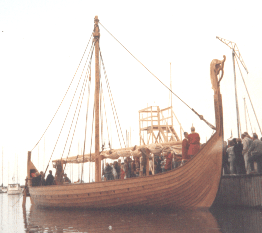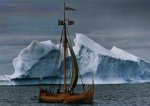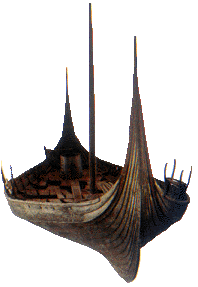
 The Viking Age
The Viking Age

Who were the Vikings?
The Vikings (also called Northmen or Norsemen) were Scandinavian pirates, traders, and explorers from the countries of Denmark, Norway, and Sweden. They were fierce warriors who stole food, treasures, and people.
Because their climate was harsh and their land filled with deep rivers, rocky coasts, and towering mountains that left little farmland, food was scarce. As a result, they turned to plundering and exploring. Along the way, they discovered Iceland, Greenland, Faroe Islands, and probably America. They also established strong footholds in Ireland, France, England, Frisia (modern Netherlands), and traveled to Spain, Italy, North Africa, Russia, Jerusalem, and the Byzantine Empire. The Viking raids lasted for over 200 years during which few countries were able to fend them off -- this became known as The Viking Age.
Although they are best known as ruthless conquerors, the Vikings were skilled shipbuilders, seamen, craftsmen, poets, and storytellers.
"Going a-Viking"

This meant to seek adventure and fight as a warrior. The first recorded Viking raid was in AD 793 when bands of Viking warriors destroyed a monastery on the small island of Lindisfarne in England. Some equipment the warriors would have had with them are: spears, helmets, shields, chain mail, battle axes, bows and arrows, and swords. They traveled on longships which carried about 50 warriors. The stern and prow of the ship were carved in the shape of a wild beast to scare off enemies. The Vikings navigated by watching the sun and stars. The ships used one square sail and were equipped with oars for when there was no wind.

Sagas
Sagas were long, thrilling tales about the adventures and battles of the Vikings. Many of these stories told of great deeds that had been done by legendary heroes. They were passed along from generation to generation.
Viking Gods
Vikings believed there were many different gods who lived in a place called Asgard. Quite often these gods were central characters in the sagas that were told.
Odin - god of war
Frigg (Odin's wife) - goddess of health
Thor - god of thunder (he had a magic hammer called Mjollnir)
Frey - god of fertility (responsible for sunshine and rain)
Freya (Frey's twin) - goddess of love

Runes
The basic Viking alphabet was called the futhark. The futhark had 16 runes (or characters) that were mostly straight lines. These runes were carved into wood or stone and used as markers.
Viking Life
Althings were open-air meetings for all freemen where local problems were discussed and new laws drawn up. Women were independent compared to other societies at that time. They could own land and were able to divorce their husbands. Although, parents arranged marriages, and men could have more than one wife. Other than warriors, Vikings worked as craftsmen, merchants, and farmers. Viking children did not go to school. They learned history, geography and navigation through the sagas that were told. Children helped with chores as soon as they were able - feeding animals and gathering firewood. Women worked on the farms, weaving material for clothes and blankets. When men were away, they were responsible for everything. Life during the Viking Age was difficult, and not many people lived past the age of 30 due to disease, wars, and hunger.
Houses
The Vikings lived in longhouses that were long, one-story wood or stone buildings with turf or thatched roofs. These homes often sheltered several families with thick skin used to separate the sleeping areas. They were dark since they had no glass for windows. Houses were often dirty because cattle was kept inside due to the weather and they threw bones and scraps on the floor!! It wasn't cleaned out until spring when the garbage was buried outside. Benches lined walls for sitting AND sleeping.
Food

The food was mainly fish and beef stew. Crops included peas, cabbage, beans, leeks and garlic. Peas were sometimes used to make bread when they had no grain. Salt was obtained by boiling sea water until all that was left was the salt. They had two meals a day (1) after early farm work was done and (2) at the end of the day. Cooking was done over an open fire, roasting meat on huge spits. Drinking horns (yes, shaped like a horn with a pointed bottom) as well as cups were used. The usual drink was mead--a sweet beer made from honey. Clothes were mostly from coarse woolen cloth with furs added in winter to keep warm. Slaves called THRALLS helped with the work to be done. They were captured, born into the life, or being punished for crimes.
For Fun
When Viking children had some free time, they played with carved wooden toys & tops, went ice skating on skates carved from cattle or horse bones, and played a board game similar to our game of chess. It was called hnefatafl.

 Return to the Fridge door
Return to the Fridge door